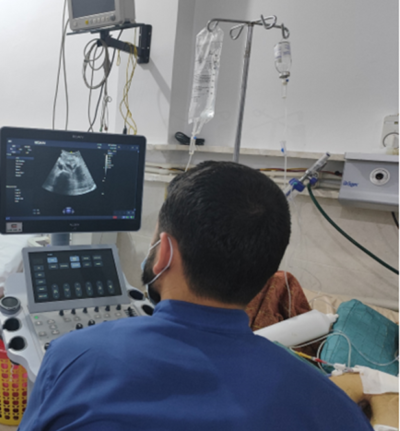Introduction
Electrical injuries are medical emergencies that can cause significant damage to multiple organ systems, including sudden cardiac arrest, arrhythmias, and neurological complications such as cerebral edema. Prompt intervention and tailored treatment are crucial for patient survival and recovery. This case study details the management of a 23-year-old male who sustained a severe electrical injury while working at a car wash center, resulting in cardiac and respiratory arrest.
The treatment involved immediate cardiopulmonary resuscitation (CPR), asynchronous defibrillation, respiratory support, and drug therapy. After intensive care, the patient showed significant improvement and was eventually discharged with a comprehensive follow-up plan. This report aims to highlight effective treatment strategies and the neurological impact of electrical injuries.
Case Overview
A 23-year-old male employee at a car washing facility was urgently brought to the emergency department at Al-Quds Hospital after suffering a severe electrical injury. Upon arrival, he was in critical condition, with no detectable central pulse or heart sounds, indicating cardiac arrest. The incident was caused by faulty electrical wiring at his workplace. His family reported no prior significant medical history.
– Emergency Response
Upon arrival at the emergency department, the medical team immediately initiated CPR and provided ventilatory support. The patient was found to be in ventricular tachycardia. The following interventions were performed:
- Defibrillation: Two asynchronous shocks of 360 joules were delivered using a single-phase defibrillator.
- Outcome: After the second shock, the patient’s pulse and breathing were restored.
– The diagnosis
The initial diagnosis was ventricular tachycardia secondary to electrical injury. A comprehensive examination later revealed an entry wound on the right hand with no visible exit wound.
– Follow-up and Intensive Care Unit (ICU) Management
First day
- Respiratory Support: The patient was placed on mechanical ventilation.
- Symptomatic Treatment: Included intravenous fluids, antacids, sedation and relaxation, and wound bandage,
- Neurological Examination: The patient had a Glasgow Coma Scale (GCS) score of 5/10 and a positive Babinski sign bilaterally.
- Imaging and Labs: A chest X-ray and echocardiography were performed, revealing a normal ejection fraction of 60% with no evidence of rib fractures or visceral damage.
- Cardiovascular Examination: Normal heart and lungs auscultation, palpable peripheral pulse, No sign of compartment syndrome.
- Vital signs: arterial pressure was 72/110 mm g, pulse 110/min, SPO2 99%.

The second day
- Improvement in Respiratory Function: The patient was gradually weaned off the ventilator 12 hours after admission and transitioned to oxygen therapy.
- Neurological Status: GCS improved to 9/10 with aphasia, and Babinski sign was absent.
- Imaging: The patient underwent a non-contrast CT brain scan, which revealed a convolution blur consistent with cerebral edema.
- Treatment: Mannitol was administered at a dose of 1 g per day, and Levetiracetam at 2 g per day, in addition to pain management and wound care.
- Vital signs werearterial pressure 131/69 mm g, pulse 95/min, SPO2 98%.
| Laboratory Analysis | |||
| Fourth day | The second day | Upon acceptance | |
| 9.5 | 10.2 | 14.9 | WBC |
| 14 | 13.2 | 13.8 | Hgb |
| 4.90 | 4.60 | 4.45 | RBC |
| 290 | 220 | 195 | Plt |
| 0.73 | 0.7 | 0.85 | Cr |
| 21 | 23 | 26 | Urea |
| 101 | 98 | 97 | Glu |
| 30 | 29 | 31 | OLD |
| 7.41 | Ph | ||
| 34 | PCO2 | ||
| 23 | HCO3 | ||
| 2.3 | Lake | ||
Day 3 and 4:
- Neurological Recovery: By Day 3, the patient’s GCS improved to 14/15, with better speech and mobility.
- CT Scan Results: Showed resolution of cerebral edema, and Mannitol was discontinued.
- Ongoing Treatment: Levetiracetam and pain relievers were continued.
- The vital signs improved, with arterial pressure stabilizing at 129/68 mm Hg, a pulse of 73 beats per minute, and an SpO2 of 99%.
The patient gradually recovered neurologically, showing steady improvement in speech and motor abilities, along with stabilization of vital signs and improved laboratory results.
– Discharge and Follow-Up Plan
Upon discharge, the patient was prescribed:
- Levetiracetam: 1g daily to prevent seizures.
- Pain Management: As needed.
- Proton Pump Inhibitors: To protect against medication-induced gastric irritation.
- Wound Care: Regular dressing of the entry wound to prevent infection.
- Cardiac and Neurological Follow-Up: The patient was advised to visit both the cardiac and neurological clinics within a week post-discharge to monitor for any complications, such as cardiac rhythm dysfunction, seizures, or impaired cognitive function.
- Safety and Education: Emphasis on workplace safety and recognition of symptoms that require immediate medical attention, such as difficulty breathing, chest pain, or changes in the nervous state.
- Self-Monitoring and Education: The patient and their family should be educated on the importance of self-monitoring, including regularly checking vital signs such as blood pressure, pulse rate, and blood oxygen levels to ensure stable health. Additionally, they should be vigilant for any neurological symptoms, such as changes in speech, movement, or consciousness, and report these immediately if they occur. Proper education on self-care, adherence to prescribed treatments, and understanding when to seek immediate medical attention concerning symptoms is essential for the patient’s recovery and long-term well-being.
Conclusion
This case underscores the importance of rapid and comprehensive management in electrical injury cases. The effective use of CPR, defibrillation, and neurological care in this young patient led to a positive outcome. Continuous monitoring and follow-up are essential to prevent long-term complications.
Discussion: Electrical Injuries – Urgent Intervention and Interdisciplinary Care
Electrical injuries pose significant risks and require immediate, multidisciplinary intervention to mitigate life-threatening complications and promote recovery. Managing these injuries involves collaboration among healthcare professionals across various specialties, focusing on several critical areas.[2]
Electrical injuries can range from mild to fatal, with severity influenced by factors such as the type of current (AC/DC), voltage, duration of exposure, and the current’s path through the body. [3]
The main types of electrical injuries include:
- True electrical injuries (where the current passes through the body)
- Flash injuries (superficial burns from arc flashes)
- Flame injuries (caused by the ignition of clothing)
- Lightning injuries (high voltage, short duration)
- Common symptoms of electrical injuries include:
- Skin burns, including severe burns in skin folds
- Cardiac effects, such as arrhythmias
- Neurological symptoms, including tingling, loss of consciousness, and seizures
- Renal complications
- Eye injuries, such as cataracts
- Bone fractures

Long-term effects may include psychological issues, kidney dysfunction, and chronic physical complications. Diagnosis typically involves patient history, physical examination, electrocardiograms, laboratory tests, and imaging studies. Management of electrical injuries requires a multidisciplinary approach, emphasizing patient stability, ongoing monitoring, and rehabilitation.
Initial Assessment and Resuscitation:
- Initial Evaluation: Follow trauma protocols focusing on airway, breathing, circulation, and spinal stabilization. A high index of suspicion for hidden injuries is essential.
- Fluid Resuscitation: Intensive fluid resuscitation with isotonic saline is crucial due to potential fluid shifts and tissue damage. The goal is to maintain urine output at 0.5-1 ml/kg/hr., particularly in cases of myoglobinuria, to monitor kidney function and tissue perfusion.
o Cardiology:
- Cardiac Monitoring: Continuous ECG monitoring is vital, as electrical injuries can lead to arrhythmias such as ventricular fibrillation. Immediate CPR and defibrillation may be necessary to restore normal heart rhythm.
- Post–Resuscitation Care: Patients require close monitoring for delayed arrhythmias and appropriate treatment.
o Neuromusculoskeletal Effects:
- Neurological Effects: Cerebral edema, a potential complication, requires immediate treatment to reduce intracranial pressure, often with Mannitol.
- Muscle and Tissue Damage: Electrical injuries can cause significant soft tissue damage, akin to crush injuries. Early surgical intervention, such as fasciotomy, may be needed to treat compartment syndrome and prevent ischemia.
o Wound Care and Burn Treatment:
- Wound Management: Careful evaluation and treatment of entry and exit wounds are essential. Early debridement and skin grafting may be required for optimal healing and functional outcomes.
- Infection Prevention: Due to the high risk of infection, vigilant wound care and monitoring are crucial, particularly in burn wounds.
o Multidisciplinary Approach:
- Team Coordination: Management of electrical injuries typically involves a coordinated team of emergency physicians, surgeons, neurologists, cardiologists, and rehabilitation specialists. This collaborative approach ensures comprehensive care that addresses all potential complications.
- Patient Education: Educating patients about the long-term impacts and necessary post-discharge preventive measures is vital for reducing the risk of future injuries.
Conclusion
This case underscores the importance of rapid response and immediate intervention in treating electrical injuries to preserve life and minimize permanent damage. Multidisciplinary coordination and comprehensive care—including respiratory support, pain management, and drug therapy—can lead to positive outcomes and improve the chances of a full recovery. Additionally, raising awareness about workplace safety measures is crucial in preventing electrical injuries and protecting individuals from future accidents.
Clarification:
This case was treated at Al-Quds Hospital, supported by Hand in Hand, by resident doctor Hikmat Al-Sultan, a resident of the Internal Medicine Specialist at the Syrian Board of Medical Specialization SBOMS, under the supervision of Dr. Dr. Aql Al-Yahya is a specialist in internal medicine and diseases of the digestive system
References:
[1] A. Kumar, K. Maini, ; Renu, and K. Affiliations, “Levetiracetam Continuing Education Activity,” 2024. Accessed: Aug. 12, 2024. [Online]. Available: https://www.ncbi.nlm.nih.gov/books/NBK499890/
[2] M. F. Kelly P O’Keefe, “Electrical injuries and lightning strikes: Evaluation and management,” UpToDate. Accessed: Aug. 12, 2024. [Online]. Available: https://www.uptodate.com/contents/electrical-injuries-and-lightning-strikes-evaluation-and-management
[3] M. R. Zemaitis, L. A. Foris, R. A. Lopez, and M. R. H. Affiliations, “Electrical Injuries Continuing Education Activity,” 2024.
4- National Institute for Occupational Safety and Health (NIOSH). Electrical Safety. NIOSH Workplace Safety and Health Topic. Electrical Safety in the Workplace | Electrical Safety | CDC. Accessed August 2024.

